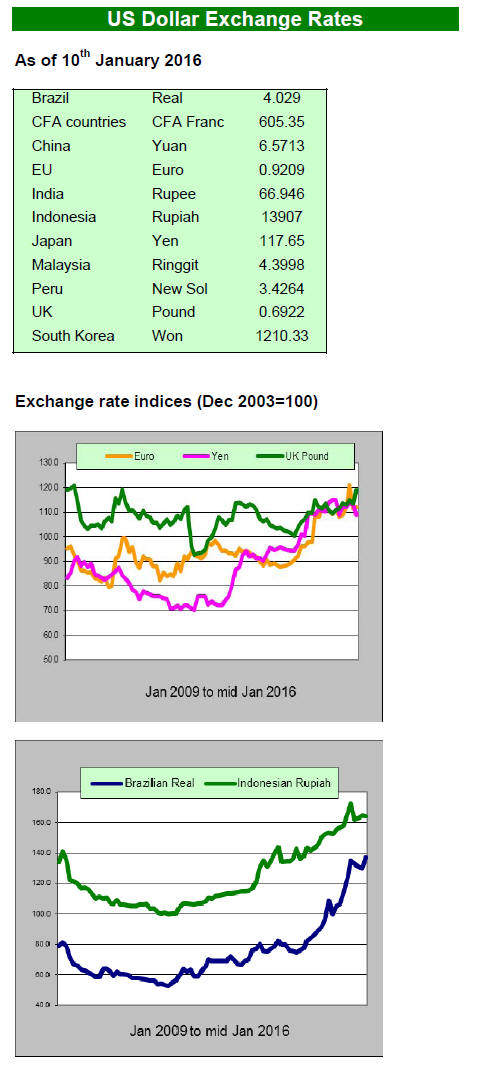2. GHANA
Third quarter export approvals up 65
percent
During the third quarter period of 2015 the Timber
Industry Development Division (TIDD) of the Ghana
Forestry Commission (GFC) vetted and approved export
contracts totalling 172,124 cubic metres. Compared to
second quarter contract volumes this represented an
increase of over 65 percent.
The table below shows the volumes of approved contracts
for the second and third quarters of 2015.
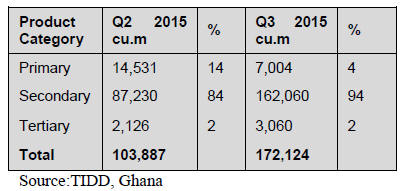
In the third quarter of 2015 the volume of approved
sawnwood contracts increased to 162,000 cubic metres, an
increase of 86% over second quarter volumes. This
increase was mainly due to the lifting of the export ban on
rosewood sawnwood during the third quarter.
Sawn rosewood accounted for 39% of the total volume of
the contracts approved in the third quarter. In addition,
compared to the second quarter, there was a 37% increase
in approvals for teak exports and a 12% increase approvals
of other sawnwood contracts.
In the third quarter there was only a minor change in
tertiary product exports approvals.
Approvals for primary product exports fell in the third
quarter of 2015. The volume of contracts for gmelina log
exports submitted in the third quarter fell almost 75%
(2,000 cu.m) compared to the second quarter. Similarly,
exporters submitted very few contracts for teak
poles/billets export. Logs go mainly to the India market
and in the third quarter contract volumes were down over
26%.
Contract submissions for the export of plywood to
neighbouring countries (overland export) fell to 19,282
cubic metres, an almost 6% decline.
Sawnwood export contracts in the third quarter accounted
for almost 80% of the total volume of contracts approved
during the third quarter (136,461 cu.m), a sharp increase
compared to the previous quarter.
The market structure for Ghana¡¯s wood product remained
unchanged in the third quarter. The regional West African
market continued to be the major destination for Ghana¡¯s
plywood.
Sliced veneer and kiln dried sawnwood exports are mainly
destined for European markets while air dry sawnwood,
especially rosewood and other high density species such as
apa, ekki and denya are for the Chinese market.
The US market continued as the major destination for
mahogany/cedrela sawnwoodber and rotary veneer. The
Middle East and Egyptian markets are emerging as a
major destination for backing grade rotary veneer.
Manufacturers pay higher taxes and levies
Two weeks before the end of 2015 the Public Utility
Regulatory Commission (PURC) announced that
electricity charges would rise over 65%. In addition, it was
announced that prices of fuel and petroleum products were
to be raised by about 28% effective 01st Jan 2016. These
increases were approved by Parliament before the
Christmas break through an emergency Energy Sector
Levy Bill (2015).
Manufacturers and business associations in the country
have called on the government to ¡®save our businesses in
2016¡¯, and to implement measures to restore confidence in
the business community. In the face of the power
shortages in 2015 most manufacturers saw output fall.
Mid-January prices
Prices for wood products remained unchanged as of mid-
January as companies are yet to resume operations after
the holidays.
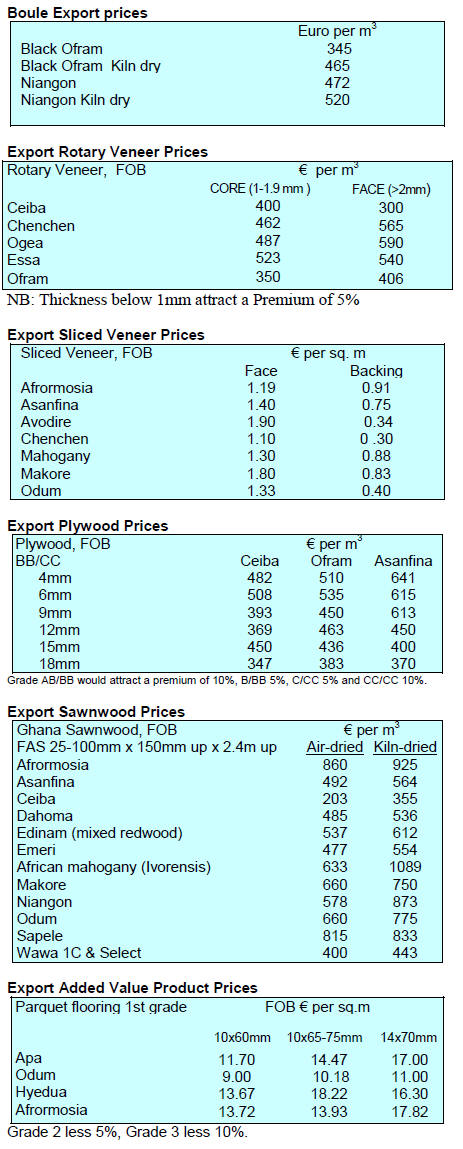
3. MALAYSIA
Game changer policies needed to cope with
the
dynamic international markets
The New Year fall in China stock markets rocked business
sentiment in Malaysia and analyst anticipate that the yuan
could weaken further which, in turn, would impact the
Malaysian ringgit ¨C good news for timber exporters but a
negative for the overall economy.
In the first week of the New Year, the Minister of
Plantation Industries and Commodities, Douglas Uggah
Embas, announced that a new national commodity policy
will be drafted. National newspapers reported him as
saying, "what is needed is game changing policies to cope
with the rapid change in science and technology.¡± Uggah
Embas said the focus of the new policy should be on
environmentally sound industries in support of ¡®green¡¯
development.
The Trans-Pacific Partnership offers an good opportunity
for Malaysian enterprises said Uggah Embas emphasising
that companies and government agencies should now be
working to gather market intelligence in advance of export
planning.
The Minister commented "Market intelligence must
always be updated with the latest information so that the
country can proactively overcome non-tariff marketing
issues and not act in a reactive and fire-fighting manner.¡±
Malaysian companies meet India¡¯s retailers ¨C net
orders worth RM 44 million
The Malaysia External Trade Development Corporation
(MATRADE) has issued a press release on its recently
organised ¡®Specialised Marketing Mission¡¯ for Malaysian
furniture makers to Mumbai. The mission, which involved
eight Malaysia¡¯s furniture suppliers, has registered sales
of RM 44 million.
The event was organised as part of MATRADE¡¯s ¡®quickwin¡¯
measures to boost exports of Malaysian furniture
products globally especially in India. The event has also
provided Malaysian companies an opportunity to meet
with India¡¯s largest retailers as well as project owners in
India.
India was identified as a high potential market for
furniture as there is a growing middle class and an
increasing expendable income which contributed to a rapid
growth in India¡¯s furniture retail. In 2014, India was the
eighth largest consumer of furniture and among the top
five retail markets in the world.
In the first ten months of 2015, India¡¯s imports of furniture
from Malaysia have grown 37.5 per cent to RM270.1
million. Malaysia was the second largest furniture
exporter to India during this period after China.
This huge jump in imports was due to competitiveness of
Malaysian products in India along with the increased
growth of organised furniture retail.
For more see:
http://www.matrade.gov.my/en/about-matrade/media/pressreleases/
press-releases-2015/4450-mission-to-promotemalaysian-
furniture-in-mumbai-proved-fruitful-14-december-
2015
New Chief Executive Officer of the Malaysian Timber
Council
Datuk D.r Abdul Rahim Haji Nik, the former Deputy
Secretary General of the Ministry of Natural Resources
and Environment, has been appointed Chief Executive
Officer of the Malaysian Timber Council (MTC). He
succeeded Datuk M Nagarajan, the former Interim.
In his new role, Datuk Dr. Abdul Rahim pledged to
continue spearheading MTC¡¯s efforts in promoting the
growth of the Malaysian timber trade and industry and the
development of markets for Malaysian timber and
furniture products globally.
For the full press release see:
http://mtc.com.my/wp-content/uploads/2015/12/New-CEO-at-
MTC.pdf
16 Malaysian furniture manufacturers to exhibit at UK
show
The Malaysian Timber Council (MTC) has announced it is
organising the participation of 16 Malaysian furniture
manufacturers at the upcoming January Furniture Show
(JFS) 2016, one of the largest furniture and furnishings
event in the United Kingdom.
See: http://mtc.com.my/wp-content/uploads/2016/01/MTCMalaysia-
Pavilion-at-JFS-2016.pdf
The MTC press release says ¡°The 576-square-metre MTC
Malaysia Pavilion at JFS 2016 will offer a platform for the
16 Malaysian furniture manufacturers to exhibit their latest
designs and products as well as develop new business
contacts and generate sales not only within the UK but
also with international buyers visiting the show.¡±
From January to October 2015, Malaysia¡¯s export of
wooden furniture to the UK totalled RM302.8 million, an
increase of 17%, year-on-year.
MTIB announces new timber import regulations
In a press release the Malaysian Timber Industry Board
(MTIB) advises timber importers that ¡°with effect from 1
January 2016, applications for import licenses of round
logs, large square and scantling (LSS) and plywood, shall
obtain legality document from producing countries.
This regulation is to fulfil the requirements of Timber
Legality Assurance System (TLAS).¡±
Press release:
http://www.mtib.gov.my/index.php?option=com_content&view=
article&id=2252%3Anew-import-regulation-under-timberlegality-
assurance-system-tlas&catid=1%3Ahighlights&lang=en
The official notification says: ¡°There are six (6)
documents adopted as legality evidence, namely:
(1) The FLEGT License under Forest Law Enforcement,
Governance and Trade;
(2) CITES Permit from member countries of Convention
of International Trade in Endangered Species of Wild
Flora and Fauna;
(3) Timber Certification such as PEFC, MTCS;
(4) Certification of Voluntary Legality Scheme;
(5) Legality Document issued by any agency / relating
association recognised by Producing Countries; and
(6) Customs Declaration Form from Producing Countries.
All importers of round logs, large square and scantling
(LSS) and plywood, are required to take note of this
regulation. As a preemptive measure, all importers of
other timber products are also advised to obtain legality
evidence from respective producing countries, particularly
for products which will undergo further processing, and to
be re-exported to the European Union countries.¡±
For the official circular see:
http://www.mtib.gov.my/repository/pelesenan/pekeliling%
20kp_import%20legality.pdf
Log prices set to rise as supplies in Sarawak become
tighter
Firm demand and a weak ringgit are likely to keep
Sarawak¡¯s export log market buoyant in 2016. A
spokesperson from Subur Tiasa Holdings said timber
consuming countries, especially India, are a steadily
growing market for tropical logs and as demand is
maintained prices rises are likely especially as supplies in
Sarawak are becoming tighter.
India is the key export market for Sarawak and currently
accounts for some 60% of the logs exported from the
State.
Plywood export prices
Plywood traders in Sarawak reported export prices:
Floor base FB (11.5mm) US$580/cu.m FOB
Concrete formboard panels CP (3¡¯ x 6¡¯) US$ 500/cu.m
FOB
Coated formboard panels UCP (3¡¯ x 6¡¯) US$ 580/cu.m
FOB
Standard panels
S Korea (9mm and up) US$ 395/cu.m FOB
Taiwan (9mm and up) US$ 390/cu.m FOB
Hong Kong US$ 420 FOB/cu.m
4. INDONESIA
300,000 ha of plantations for biomass by
2019
As a contribution to energy security Indonesia has adopted
a policy on bio-fuel/diesel blending. From the beginning
of this year the aim is to begin using 20 percent biodiesel
blending (B20 blending).
If the B20 policy can be made effective the plan is to
move to a B30 target for 2020. A level of 30 percent
blending is thought to be the maximum that can be
achieved without major technical modifications to
standard diesel engines.
The Ministry of Environment and Forestry is aiming for
the establishment of 300,000 ha of forest plantations for
biomass energy by 2019.
New procedures for wood product imports
The Ministry of Trade has issued an update on procedures
for wood product imports. In its latest directive, Ministry
of Trade 1068 / M-DAG / SD / 12/2015 December 21,
2015, provisions on the import of forestry products are set
out and procedures for applications for an import license
are explained.
This new regulation stems from the requirements of the
EUTR which requires importers to exercise due diligence.
For more see:
http://silk.dephut.go.id/index.php/article/vnews/141
Export promotion the focus of new economic stimulus
package
The government will introduce a further round of
economic stimulus measures early this year focusing on
export promotion.
Darmin Nasution, Minister for Economic Coordination
said the government aims to encourage financing of
export-based industries and that it is likely a national
institution will be asked to take responsibility for
promoting exports of wood products, furniture and
textiles.
AEC trade pact offers opportunity for more exports of
wood products
The ASEAN Economic Community (AEC)/MEA came
into being on 1 January 2016 and Indonesia is a party to
this new community. Members have agreed that goods and
services within member countries of ASEAN plus China,
Japan and South Korea will eventually all be duty fee.
A spokesperson from the Ministry of Trade has said the
ministry is optimistic Indonesia can expand exports
through the new trade group.
Indonesia trade with ASEAN partners has expanded in
recent years with the non-oil trade balance between
January and October last year more than doubling to
US$1.6 billion.
The Director General of the National Export
Development
Division in the Ministry of Trade, Nus Nuzulia Ishak, said
because of the new trade deal there are significant
opportunities for expanding exports of wood products,
pulp and furniture to China, Japan and South Korea.
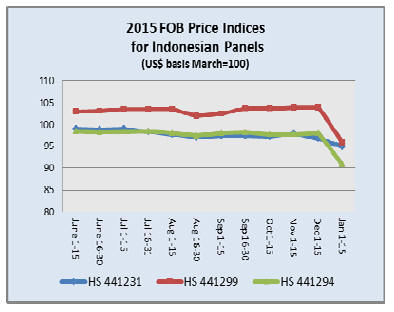
5. MYANMAR
Confusion over allowable cut for 2016/17
The Myanmar newspaper ¡°The Daily Eleven¡± quoted Dr.
Kan Zaw, Minister for National Planning and Economic
Development, as saying that authority would be granted
for the extraction of 60,000 cubic tons of teak logs and
1,499,111 cubic tons of other hardwood logs in the
financial year of April 2016 to March 2017.
In the 2015-16 financial year authority was granted for
felling of 88,044 cubic ton of teak logs.
This statement contradicts what the Myanma Timber
Enterprise (MTE) earlier announced. MTE is on record as
saying just 30,000 cubic ton of teak logs will be harvested
in 2016-17. The local media have noted that there is a risk
of over-harvesting and this has attracted public concern in
the past.
NGOs seek participation in talks on border investment
with China
The NGOs, Blue Moon Fund and Global Environmental
Institute have asked to be invited to participate in
negotiation between Myanmar and China on the
establishment of wood processing industries and
plantations along the border which have been proposed
under an agreement aimed at eliminating the illegal border
trade.
EU FLEGT facilitator appointed
The EU has appointed Mr. Huge Speechly as FLEGT
Facilitator to accelerate the preliminary negotiations on a
FLEGT VPA in Myanmar. Dr. Marlene Buchy was earlier
appointed as Technical Advisor to the Ministry of
Forestry.
Civil society groups and the Myanmar private sector have
launched a series of awareness raising seminars with the
financial assistance from The Global Timber Forum.
Regions to get more say on investments
The Government has amended the Foreign Investment
Law and Myanmar Investment Law to divest some
authority to regional and state authorities in managing
investment related to natural resource.
However, analysts say it is not yet clear if forest
management will be included and if so how revenue will
be shared between the Union Government and regions and
states.
Government policy on forestry eagerly awaited
The private sector is waiting for new government to
announce details of its policy on forestry and the timber
trade. The high level of deforestation is of great concern
and is said to be linked to over-extraction of logs, much of
which was illegally exported. However, as analysts point
out, there are many other drivers of deforestation.
The other challenge is illegal felling for the domestic
market. Recently, a Forest Officer was shot in Northern
Shan State while he was trying to stop illegal log
harvesting.
Teak sales yet to begin
MTE will resume monthly tender sales this month after a
two month suspension. Observers say the MTE is set to
offer for sale just 200 Hoppus tons (HT). This is a
disappointment to the domestic industry which is
experiencing a shortage of logs.
Analysts estimate that there are around 200,000 HTs of
teak logs ready for sale but most are not owned by MTE. It
has been reported that in order to secure these privately
owned logs the domestic millers have to pay a premium to
the owners over and above the list price set by MTE.
November teak prices
A total quantity of 103 cubic tons sawn teak was sold by
open tender. Average prices are shown below:
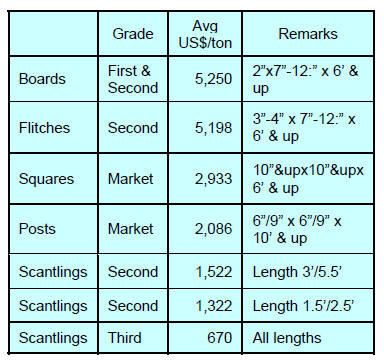
6.
INDIA
State Committees for Wood-Based Industries
secure
authority to license wood processing enterprises
The Supreme Court of India has empowered State Level
Committees for Wood-Based Industries (¡°SLCs¡±) to take
decisions on licensing wood processing enterprises instead
of approaching the Central Empowered Committee (CEC).
This decision was based on recommendations of the State
Forest Departments. Now SLCs will take care of
guidelines and procedure and can take decisions regarding
the grant of licenses for the wood-based industries.
In each State and Union Territory in which a SLC has not
been constituted as yet an SLC under the Chairmanship of
the Principal Chief Conservator of Forests with a
representative of the Ministry of Environment and Forest
and Climate Change (¡°MoEFCC¡±) and an officer of the
State Forest Department/Industries Department will
immediately be constituted.
The MoEFCC is authorised to issue appropriate guidelines
in conformation with the orders and directions issued by
Supreme Court along with guidelines relating to
assessment of timber availability for wood-based
industries and the granting of licenses including
applications for additional processing equipment. of new
machineries.
Auction of domestic teak in Western India
Auctions at forest depots in South Dangs were undertaken
from 21 December to 5 January 2016. Approximately
11,000 cbm of teak and other hardwood logs were offered
for sales. Observers say the quality of logs was good,
sales brisk and a firm upwards tempo in prices was seen
because imported timber is becoming more expensive due
to the dollar/rupee exchange rate fluctuations.
Average prices recorded at the most recent auction were as
follows:
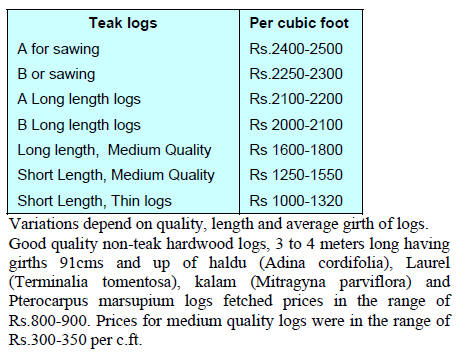
Prices for imported plantation teak, C&F Indian
ports
The volume of larger girth logs increased recently and this
has lifted the landed costs from several suppliers.
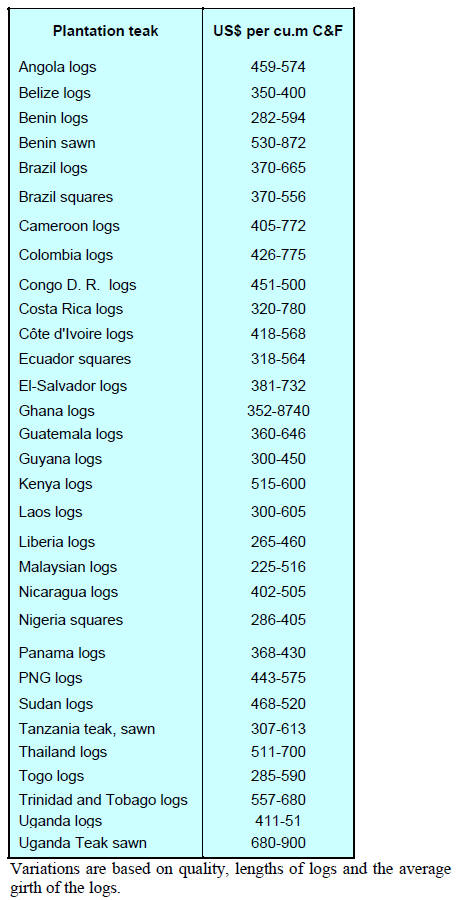
Myanmar teak logs sawn in India
No price movements have been reported.
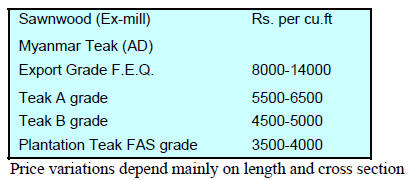
Prices for locally sawn hardwoods
Prices are unchanged from the end of November.
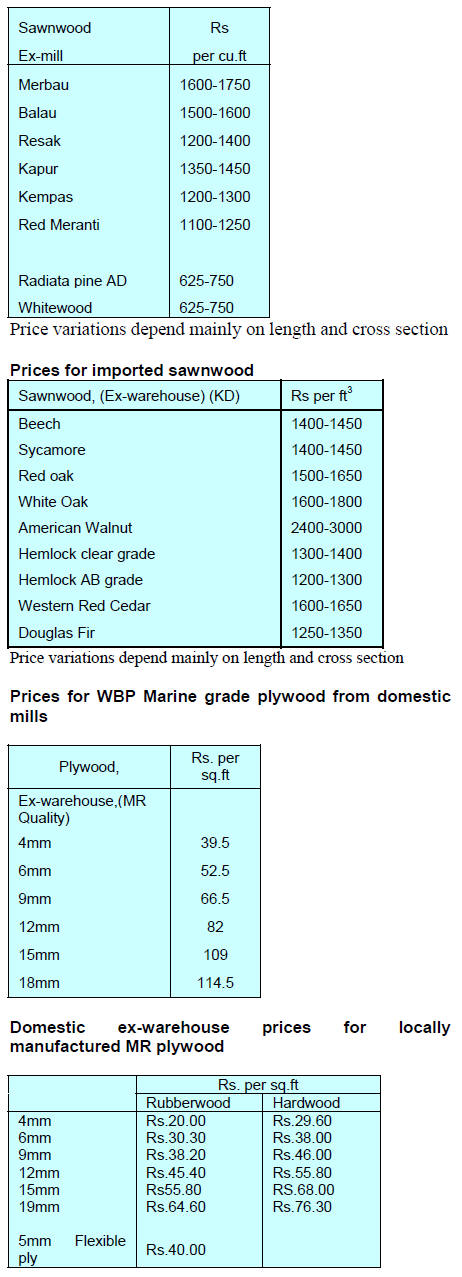
7.
BRAZIL
Brazilian Coalition proposes improved
transparency to
tackle illegal activities
Low impact and verified legal harvesting of Brazilian
native forests can strengthen the tropical timber market
and through this provide opportunities for landowners and
forest communities.
The Brazilian Coalition for Climate, Forestry and
Agriculture has proposed that the area of forest under SFM
in Brazil should be expanded tenfold from the current
level to reach 30 million hectares (around 7% of the
Amazon forest) by 2030.
The main challenge to convert this proposal into reality is
the elimination of illegal activities in the supply chain.
The Brazilian Coalition has proposed measures such
improved transparency in the forest management plan
approval process and points out that strengthening the
tropical forest economy depends on traceability across
harvesting, transport and processing as consumers are
increasingly requiring evidence of the origin of wood
products. The Coalition has said traceability should be
considered as a condition for public procurement.
Forest concessions in Amap¨¢ to generate R$500
million from fees and royalties
The Amap¨¢ State Forestry Institute (IEF), in partnership
with other environmental organizations and rural
communities, anticipates that sustainable harvesting in
concession in the State of Amap¨¢ (Amazon region) over
the next 30 to 40 years and could generate around R$471
million from just concession fees and royalties.
IEF calculated the potential production volume at around
115,000 cubic metres (standing timber). At a concession
fee of between R$25.30 and R$41.50 per cubic metre
established by the Forest Concession Bidding
Announcement, production would yield up to R$4.7
million annually.
In addition royalty revenue could reach R$280 million
much of which could be invested in developing areas for
the benefit of forest communities.
Brazilian furniture export to rise in 2016
According to the Brazilian High-end Furniture
Manufacturers Association (ABIMAD) the expectation is
that furniture exports in 2016 will expand nearly 6% over
2015 levels. Although not a startling growth a growth, this
should help enterprises in the sector to maintain profit
levels through trade in high-end furniture.
According to ABIMAD exports to Argentina are likely to
increase as the new government there tackles the
economy. Argentina is an important destination for
Brazilian furniture and an improvement in exports will
greatly benefit Brazilian manufacturers who suffered
because the economy in Argentina was weak.
In addition, recovery in the housing market in the
United
States is good news for Brazilian manufacturers. The US
is historically a major buyer of Brazilian furniture.
European countries are also on radar of furniture
manufacturers and the expectation is that exports to the
EU will grow in 2016.
Pulp, wood panel and paper export growth in 2015
Exports of pulp, wood panels and paper increased between
January and November 2015. Pulp exports totaled 10.5
million tons, an increase of 9% over the same period in
2014.
The Brazilian wood panel sector exported 564,000 cubic
metres in the January to November period in 2015 a 44%
growth over the same period in the previous year.
In the first eleven months of 2015, revenue from exports
of pulp, wood panels and paper totaled US$7.1 billion, a
5.3% growth over the same period of 2014.
The trade balance of the pulp, wood panel and paper sector
from January to November 2015 was US$5.9 billion, an
increase of 16.4% compared to the same period in 2014.
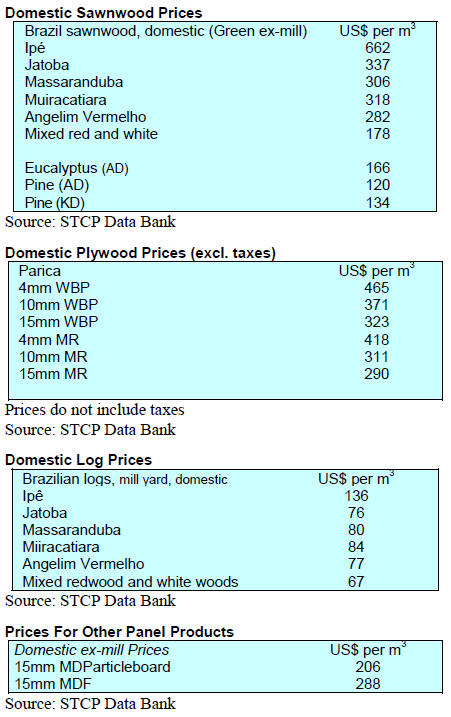
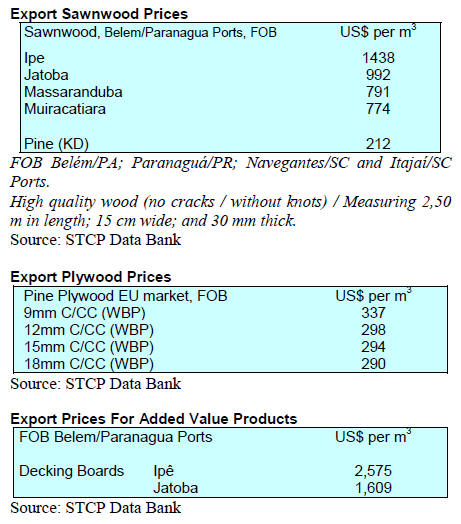
8. PERU
Training professionals to be Forest
¡®Regents¡¯
A two-week training for forestry sector specialists was
held in late November 2015 with the support from national
professional associations as well as experts from the
Forestry Stewardship Council (FSC), the Peruvian Society
for Environmental Law (SPDA) and ProAmbiente
Program. The purpose was to establish a cadre of so-called
¡®regents¡¯ who will be responsible for the sustainable use of
the national forests.
The idea of ¡®regents¡¯ was introduced in the new Forestry
and Wildlife Law and Peruvian regulations. A total of 60
professionals, including biologists, veterinarians and
foresters from 19 regions participated in the first ¡®Forest
Regents¡¯ training.
Fabiola Muñoz, Executive Director of SERFOR said the
aim is to have body of forest managers and highly
qualified wildlife specialists with enhanced knowledge so
they can plan and execute forest management. The first
round of training was held for 60 professionals from 19
regions of Peru, including Lima, Madre de Dios, Loreto,
Cajamarca, Cusco, San Martin, Piura, Huanuco.
Raising finance the greatest hurdle in unlocking the
potential in the forestry sector
At a recent meeting, Piero Ghezzi, Minister of Production
took stock of achievements in implementation of the
National Productive Diversification Plan (PNDP) launched
in August 2014.
Forest production is expected to contribute more to GDP
growth and the minister highlighted new investments that
have already begun in the forestry sector which will
eventually lead to increased exports.
The Minister drew attention to the changes to
regulations
on investment in R&D, which took effect on 1 January. He
also mentioned the National Quality Institute (INACAL)
which was created to strengthen infrastructure aimed at
improving productivity in the private sector.
One of the greatest hurdles to unlocking the potential of
the forestry sector was the difficulty investors face in
raising finance.
Firm domestic demand to boost industrial output
Lima Chamber of Commerce's Institute of Economics and
Business Development (IEDEP) has forecast that during
the current year the mining sector is expected to expand by
7.7% thanks to copper production.
IEDEP says in a press release : ¡°The dynamism of the
mining, construction and trade sectors would be the main
drivers of growth of the Peruvian economy this year
projected at 3%.
Meanwhile, the expansion of the construction sector
would amount to 2.5% by the progress in the
implementation of the pipeline infrastructure that
quantifies BCR 4400 million for the period 2015- 2017.
Regarding growth industrial output is expected to expand
around 4% due to a recovery in domestic demand.
On the demand side, the Institute notes that the thrust
would come from three factors: first from increased
private consumption of 3.9% slightly above the 3.7% of
2015; second, from the advance of public investment
(4.6%) an increase of 3.9% in the budget for capital
expenditure for this year and finally private investment
(2.2%), provided that business confidence recovers.
IEDEP mentioned that while Peru would grow by 3% this
year this is insufficient for the country to completely
eradicate extreme poverty by 2021.¡±
For more see:
http://www.camaralima.org.pe/principal/noticias/noticia/mineriaconstruccion-
y-comercio-impulsarian-la-economia-en-el-
2016/470
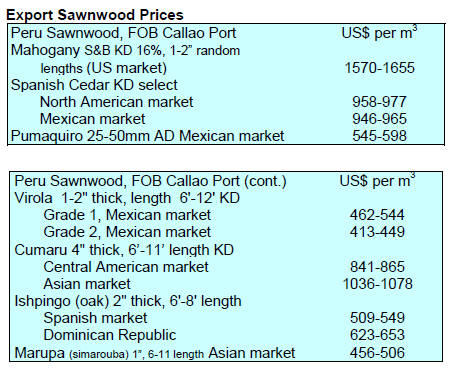
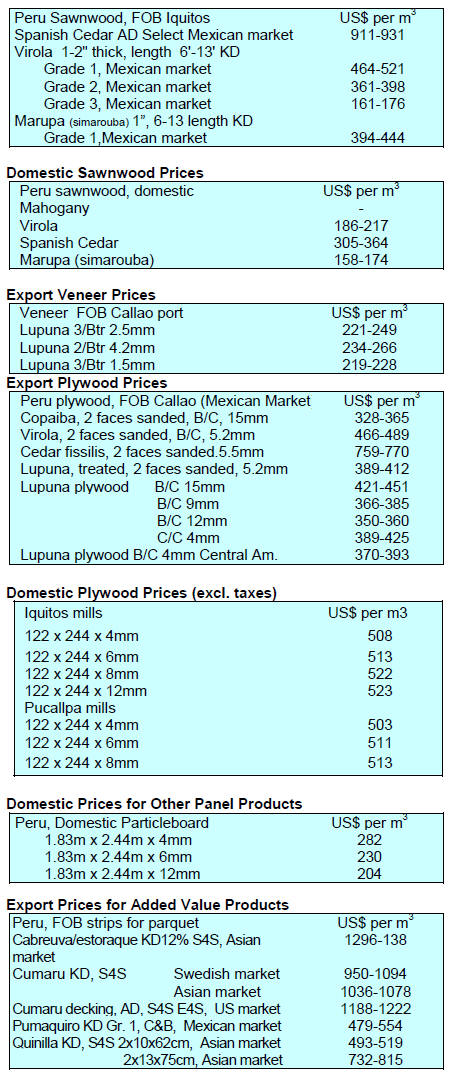 .
GUYANA
.
GUYANA
